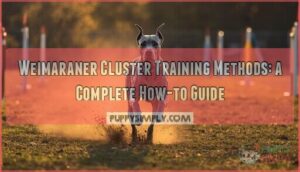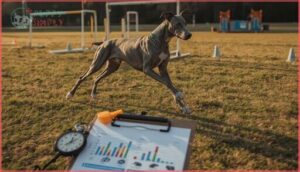This site is supported by our readers. We may earn a commission, at no cost to you, if you purchase through links.
Your Weimaraner can sprint full-speed across a field for twenty minutes straight, then turn around and demand another round before you’ve caught your breath. Traditional training methods often fall flat with these tireless athletes because they’re built for endurance, not moderation.
Cluster training flips the script by breaking intense work into short, explosive bursts with built-in recovery windows. This approach channels your Weimaraner’s natural stamina without frying their nervous system or testing your patience.
The method mimics how wild canines naturally move—quick bursts of pursuit followed by strategic rest—which makes it surprisingly effective for breeds that seem to have endless batteries. You’ll discover how to structure sessions that exhaust your dog’s body while keeping their mind engaged and enthusiastic for more.
Table Of Contents
- Key Takeaways
- What is Cluster Training for Weimaraners?
- Key Principles of Weimaraner Cluster Training
- Designing a Cluster Training Program
- Implementing Effective Cluster Training Sessions
- Tracking Progress and Troubleshooting Challenges
- Frequently Asked Questions (FAQs)
- How do I address separation anxiety in cluster training?
- What is the ideal age to start cluster training Weimaraners?
- Can cluster training be effective for older Weimaraners too?
- Can cluster training help with separation anxiety issues?
- What dietary adjustments support cluster training performance?
- Is cluster training suitable for Weimaraner puppies?
- How does weather impact cluster training session effectiveness?
- Conclusion
Key Takeaways
- Cluster training breaks exercise into short, intense bursts (30-60 seconds) with built-in rest periods (45-60 seconds), mimicking how wild canines naturally move and preventing burnout while channeling your Weimaraner’s high energy effectively.
- This method delivers faster skill mastery and lower stress compared to traditional weekly classes because brief, frequent micro-sessions (even 30 seconds repeated throughout the day) match how Weimaraners actually learn without overwhelming their sensitive nature.
- Structure your program with 10-15 minute sessions two to three times weekly, using progressive overload by adding only 10% more work every few weeks while monitoring for overtraining signs like limping, reluctance, or loss of enthusiasm.
- Track your dog’s heart rate, recovery time, and engagement levels to adjust intensity and rest periods, ensuring you’re building fitness without causing injury or burning out your Weimaraner’s natural drive to work.
What is Cluster Training for Weimaraners?
Cluster training is a structured approach that breaks exercise and learning into short, intense bursts with built-in rest periods between each set. For a high-energy breed like the Weimaraner, this method offers a smart way to channel their natural drive while preventing burnout and keeping their mind sharp.
Let’s look at what cluster training means for your dog, why it works so well for active breeds, and how it differs from the training methods you might already know.
Cluster Training Defined
Cluster training for Weimaraners breaks work into short, high-quality bursts with brief pauses built right in. Think of it as organizing retrievals or agility runs into small groups—say, three quick repetitions, then a 10-second breather—before tackling the next cluster.
This intra-set rest helps your dog maintain speed and precision while managing fatigue, distinguishing it from traditional continuous drills or longer HIIT intervals. This approach can help recruit more motor units for enhanced performance.
Benefits for High-Energy Breeds
High-energy breeds like yours thrive when training methods match their drive. Cluster training offers specific advantages:
- Energy Expenditure: Short bursts with rest manage your Weimaraner’s stamina better than marathon sessions, preventing burnout while delivering the vigorous physical activity they crave.
- Enhanced Learning: Brief recovery windows between reps improve focus and skill retention in these intelligent dogs.
- Injury Prevention: Built-in pauses protect joints during intense work.
This approach balances cardiovascular fitness gains with stress regulation. Weimaraners need to have regular vigorous exercise to maintain health.
Differences From Traditional Training
Traditional training relies on extended weekly classes that can overwhelm your Weimaraner’s sensitive nature. Research shows weekly single sessions produced faster learning than daily multi-session blocks, yet the conventional approach still dominates.
| Aspect | Traditional Training | Cluster Training |
|---|---|---|
| Session Duration | 30–60 minutes weekly | Multiple 10–15 minute bursts daily |
| Rest Periods | Minimal breaks within sessions | Structured 30+ minute recovery intervals |
| Method Focus | Often includes aversive methods | Reward focus with positive reinforcement techniques |
| Learning Speed | Slower acquisition, higher stress | Faster skill mastery, lower cortisol |
| Owner Involvement | Once-weekly attendance | Daily engagement in dog training tips routines |
The shift toward brief, frequent repetitions matches how Weimaraners actually learn. Studies found dogs trained with reward-based effective training methods showed less stress and more optimistic behavior than those facing corrections. Your involvement matters more than session length—handlers spending four-plus hours weekly achieved considerably higher performance.
Cluster formats protect your dog’s welfare while building skills faster. Instead of drilling commands until attention fades, you’ll work in micro-sessions around daily routines. This mirrors how professional Weimaraner training methods now emphasize “tiny sessions” of 30 seconds, repeated throughout the day, rather than exhausting your dog in one go.
Cluster training replaces exhausting drills with 30-second micro-sessions repeated throughout the day, protecting your Weimaraner’s welfare while accelerating skill development
Key Principles of Weimaraner Cluster Training
Getting cluster training right comes down to understanding a few core principles that make the method work for your Weimaraner. These fundamentals determine how you’ll structure sessions, manage energy levels, and choose activities that match your dog’s needs.
Let’s break down the three key elements you need to build an effective cluster training approach.
Structuring Cluster Sets and Reps
When you map out cluster training methods for your Weimaraner, think of each session as a series of high-quality mini-workouts. Structure three sets per exercise, starting with 5–7 reps in Set Rep Ranges that prioritize form over quantity.
Keep Session Duration under 15 minutes and use Frequency Blocks spread across the week—once or twice weekly often beats daily drills. Intensity Management and positive reinforcement keep your dog sharp without burning out.
Optimal Rest Periods for Dogs
During recovery windows, your Weimaraner training needs both physical and mental exercise breaks to support injury prevention and behavioral aspects. Within each session, pair 30-second bursts with 45–60 seconds of walking to clear Recovery Markers like lactate.
Between sessions, schedule 24–48 hours of lighter physical activity. Age Modulation matters—puppies under six months demand gentler loads, while older dogs benefit from fitness levels-appropriate rest days that sustain energy levels without overload.
Selecting Suitable Exercises and Activities
Beyond choosing any single drill, you should blend Activity Intensity levels across your Weimaraner training plan. Combine 15-minute bursts of fetch or running with 45-minute walks, then rotate in weaving poles, scent work, and puzzle toys to satisfy Breed Instincts.
Exercise Variety protects joints through Injury Prevention while mental exercise counters boredom. Monitor Environmental Factors like heat to keep each physical activity safe and effective.
Designing a Cluster Training Program
Before you jump into cluster training with your Weimaraner, you need a plan that fits your dog’s current fitness level and energy needs.
A well-designed program balances intensity with recovery, keeping your high-energy companion engaged without risking injury or burnout.
Here’s how to build a cluster training routine that works for both you and your dog.
Assessing Your Weimaraner’s Fitness and Needs
Before you dive into cluster training, take stock of where your Weimaraner stands right now. This assessment protects joint health and prevents overtraining signs from derailing your program.
- Check body condition score using the 9-point scale (ideal is 4–5) to gauge if weight adjustments are needed
- Measure exercise volume your dog currently completes—Weimaraners need 1–2 hours daily minimum
- Monitor resting heart rate (normally 60–100 bpm for adults) as your baseline fitness indicator
Setting Realistic Training Goals
Set goals that match your Weimaraner training capacity—a breed that demands 2 hours of daily exercise needs timeframe milestones built around both physical outlets and focused obedience training.
Plan for 1–2 sessions of 15–30 minutes per day, targeting an 80% success rate before increasing difficulty. Realistic performance targets prevent burnout: aim for several weeks of consistent practice rather than rapid results, and track your daily dose to maintain steady progress in dog behavior and dog training.
Creating Sample Cluster Training Routines
Your Weimaraner training blueprint combines high-intensity bursts with structured rest—think 30-second sprints followed by 45-second recovery, repeated 4–6 times for a 10–15 minute session after a proper warm-up.
- Beginner routine: 30-second fetch or flirt pole, 60-second walk, 4 repetitions with 5-minute warm-up
- Intermediate routine: 60-second uphill run, 60-second rest, 6 repetitions within 15 minutes
- Expert routine: 2-minute fast trotting, 1-minute walk, 5–8 repetitions
- Play-based option: 30-second chase games, 45-second calm praise breaks, 5 rounds
Incorporating Progressive Overload Safely
Progressive overload means gradually increasing your Weimaraner’s training demands—but only after your dog masters the current level. Add 10% more work every few weeks, adjusting one variable at a time: duration, intensity, or frequency. Monitor heart rate during sessions and watch for limping or reluctance to move, clear signs you’ve pushed too hard.
Structured recovery prevents injury—alternate harder and easier days, letting muscles adapt before ramping up again.
| Training Variable | Safe Progression Example | Warning Signs of Overload |
|---|---|---|
| Duration | Add 2–3 minutes per week | Reluctance to continue, excessive panting after rest |
| Intensity | Increase sprint speed by 5–10% monthly | Limping, difficulty rising next day |
| Frequency | Add one session per week after 3–4 weeks | Sore muscles, avoiding stairs or play |
| Recovery | Maintain 1–2 rest days between hard sessions | Declining performance, loss of enthusiasm |
Implementing Effective Cluster Training Sessions
Once you’ve built your cluster training program, it’s time to put it into action with your Weimaraner. The success of each session depends on how well you prepare, execute, and wrap up the work.
Let’s walk through the practical steps that will help you run smooth, effective cluster training sessions from start to finish.
Proper Warm-Up and Preparation
Before jumping into cluster sets, spend at least 5–10 minutes on a brisk walk or gentle trotting—this Warm-up Duration raises body temperature and prepares muscles for action. Mix in circles or sit-to-stand drills for Exercise Selection.
Watch for limping or fatigue; Safety Monitoring matters. Prep for weather and hydrate well—Environmental Prep keeps your Weimaraner training both safe and effective.
Executing Cluster Sets With Consistency
Once you’ve warmed up, maintaining Rep Quality across each cluster is where real progress happens. Aim for 30 seconds of intense fetch or sprints, then rest 45 seconds—this Session Duration pattern promotes Focus Preservation.
Your Weekly Schedule should include:
- Two to three cluster sessions per week
- 10–15 minute total training blocks
- Consistent work-to-rest ratios (30:45 or similar)
- Close Fatigue Monitoring for limping or distraction
These Weimaraner training techniques keep dog behavior management steady and effective.
Managing Rest and Motivation
After establishing your work-to-rest ratios, you’ll need to watch for overtraining indicators like tail-tucking or reluctance. Short session lengths—10 to 15 minutes—keep motivation high. Between cluster days, rest day activities such as gentle walks or mental exercise games support recovery. Break frequency matters: studies show pauses can boost retention by 30 percentage points. If your Weimaraner loses focus, shifting to calm settling drills or impulse control work maintains engagement without exhausting energy reserves.
| Activity Type | Purpose | Duration/Frequency |
|---|---|---|
| High-intensity clusters | Build fitness & focus | 2–3 sessions/week |
| Rest day walks | Active recovery | 20–30 min/day |
| Mental exercise puzzles | Sustain motivation | 10 min daily |
| Calm settling practice | Impulse control | 5 min between clusters |
Cool-Down and Recovery Strategies
Once your Weimaraner finishes each high-intensity cluster, an active cool-down—five to ten minutes of easy walking—helps heart rate drop gradually and aids muscle recovery. Hydration strategies matter: nutrient-enriched water can lower core temperature by nearly a degree.
Gentle massage benefits tight muscles, while hydrotherapy uses like swimming offer low-impact recovery. Monitoring temperature and pulse ensures safe cooling after demanding mental exercise and impulse control work.
Tracking Progress and Troubleshooting Challenges
Tracking your Weimaraner’s progress keeps you from spinning your wheels and helps you see what’s actually working. You’ll need to watch for signs that your dog has hit a plateau or lost interest in training sessions.
Let’s walk through the key areas to monitor and the practical steps you can take when challenges pop up.
Monitoring Performance and Adjusting Variables
Tracking performance isn’t guesswork—it’s where smart training happens. Use heart rate variability monitoring and exertion indicators to see how your Weimaraner reacts to each session.
Watch for overtraining signs like reluctance to work or irritability, common behavioral issues that signal you’ve pushed too hard.
Adjust training intensity based on breed risks such as joint sensitivity, applying load modification principles to keep obedience work safe and effective.
Recognizing and Overcoming Plateaus
When does your Weimaraner stop making progress despite consistent effort? Behavioral indicators like inconsistent cue responses or re-emerging behavior problems signal a plateau. Overtraining effects—fatigue, mistakes, slower learning—often stem from poor session structure.
Strategic modifications work best: simplify exercises, vary one environmental factor at a time, and shorten sessions to 5–10 minutes. These adjustments restore momentum in Weimaraner training when behavioral issues stall your dog training program.
Maintaining Engagement and Preventing Burnout
Sustained motivation requires deliberate balance. Your Weimaraner needs activity variety—rotate physical exercise with mental enrichment like puzzle games to prevent habituation.
Stress monitoring catches early fatigue signs: excessive panting, lip-licking, or disengagement signal overwork. Rest scheduling matters more than you think; 12–14 hours of daily sleep fosters learning.
Stick with positive reinforcement training methods and build predictable work-rest cycles. This approach keeps Weimaraner training effective long-term without burning out your dog.
Frequently Asked Questions (FAQs)
How do I address separation anxiety in cluster training?
Picture a Weimaraner pacing as you grab your keys—cluster training won’t fix separation anxiety.
Address it through gradual departures, enrichment activities, and owner consistency. Weimaraners with comorbid anxieties may need medication support alongside behavior modification.
What is the ideal age to start cluster training Weimaraners?
You can begin mental training and low-impact obedience drills with Weimaraner puppies around 8 weeks old, during the critical socialization window, while postponing high-intensity physical cluster work until after 12 months.
Can cluster training be effective for older Weimaraners too?
Your silver-haired Weimaraner isn’t ready for pasture just yet. With individual assessment and arthritis considerations, cluster training offers senior dog fitness, cognitive benefits, and session safety—shorter work blocks preserve your older companion’s spark.
Can cluster training help with separation anxiety issues?
Yes, cluster training can help reduce separation anxiety in Weimaraners through structured routine benefits and exercise program design.
Multiple short sessions with enrichment alone-time build calmness, addressing breed-specific anxiety common in this velcro breed.
What dietary adjustments support cluster training performance?
While most pet foods work for couch potatoes, athletic Weimaraners thrive on higher-fat formulas—aim for 18-20% fat and 28-30% protein.
Feed 10-12 hours before intense sessions, hydrate freely, and adjust portions to match workload.
Is cluster training suitable for Weimaraner puppies?
Traditional cluster training isn’t appropriate for Weimaraner puppies due to exercise intensity limits and puppy joint health concerns.
Focus puppy training methods on cognitive enrichment instead, saving strength work until maturity considerations allow, usually around 18 months.
How does weather impact cluster training session effectiveness?
Like marathon runners avoiding midday heat, your training sessions face real weather challenges.
Heat effects reduce intensity, cold impact shortens duration, and humidity effects alter scent work—forcing you to adjust timing, location, and exercise structure for best Weimaraner training outcomes.
Conclusion
The irony? Your Weimaraner’s endless energy actually makes training easier once you stop fighting it. Weimaraner cluster training methods work because they embrace what exhausts other approaches—that relentless drive to keep moving.
You’ve now got a framework that turns stamina into an advantage rather than an obstacle. Start with one cluster session this week, watch how your dog responds, and adjust from there. The hardest part is simply beginning.
- https://showsightmagazine.com/dog-breeds/weimaraner/
- https://www.weimaranerclubofamerica.org/field_training.php
- https://pmc.ncbi.nlm.nih.gov/articles/PMC11083790/
- https://wagwalking.com/training/obedience-train-a-weimaraner
- https://www.provendogtraining.com/dog-group-training-classes-benefits-and-best-practices/













